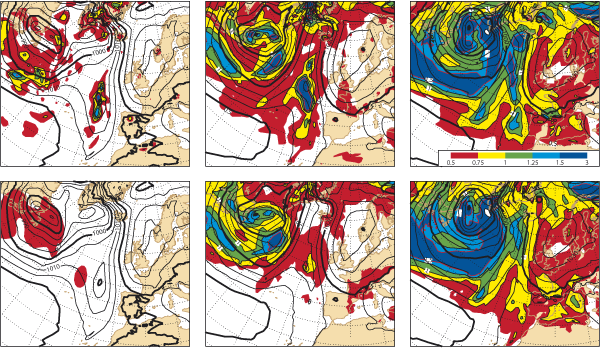

On Tuesday, 22 June 2010, ECMWF implemented an Ensemble of Data Assimilations (EDA). The EDA is designed to provide information about the uncertainty in the analysis of atmospheric observations that provides the starting point for ECMWF's forecasts. In this implementation, the output from the EDA is used to improve the representation of initial-time uncertainty in the forecasts of the Ensemble Prediction System (EPS). The result is a more reliable estimation of forecast uncertainty.
The new IFS model cycle is labelled 36r2. The initial perturbations for the EPS are now constructed from a combination of initial singular vectors (as before) and EDA-based perturbations (which replace the evolved singular vectors). The EDA consists of an ensemble of ten independent lower-resolution (T399) 4D-Var assimilations that differ by perturbing observations, sea surface temperature fields and model physics. The computing cost is significant, similar to running the deterministic analysis suite.
The main reasons for implementing the EDA are:
- to provide estimates of analysis uncertainty;
- to provide improved initial perturbations for the EPS;
- to provide the data assimilation system with important information about the quality of the preceding short-range forecast (the background fields). It can therefore be used to estimate flow-dependent background errors in the deterministic 4D-Var assimilation system. This application is under development.

Impact of the Ensemble of Data Assimilations on the EPS spread: ensemble mean (black contours) and spread (standard deviation; shaded) mean sea-level pressure fields for forecasts from 12 UTC 11 December 2009 for the new system including EDA perturbations (top) and the previous operational system (bottom) at initial time (left) and for 12-hour (middle) and 24-hour (right) forecasts. The new initial perturbations produce more structured and geographically varied initial spread.
The EDA has run in experimental mode since 5 October 2009, and its use in the EPS has been tested thoroughly. Results based on about 130 cases indicate that the EPS initial perturbations have a better geographical and vertical coverage than in the earlier system. This results in a better spread-skill relationship in the early forecast range over the extra-tropics, and for the whole forecast range over the tropics. Over the tropics the substantial increase of the EPS spread helps correct the under-dispersion of the ensemble. The new version of the EPS has higher skill than the previous one in both extra-tropical hemispheres and especially in the tropics. Two articles are due to appear in the Spring issue of the Newsletter discussing this latest change in more details.
